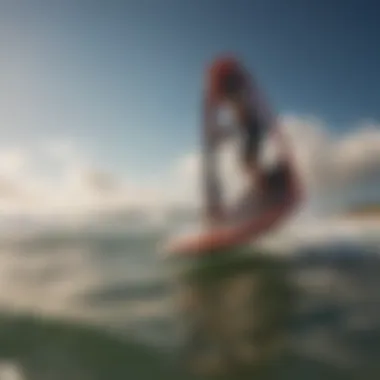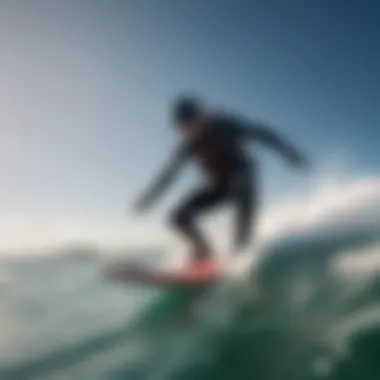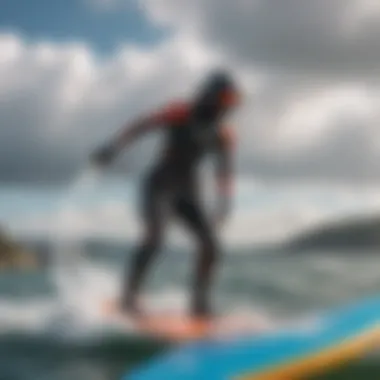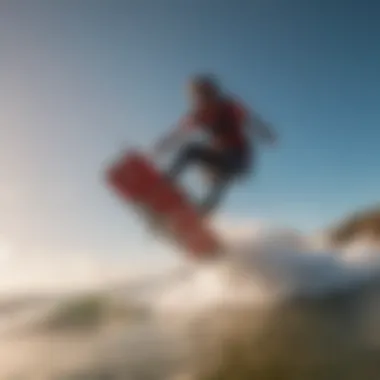Unveiling the Intricacies of Kitesurfing Board Selection and Features


Equipment Reviews
Kitesurfing boards are crucial equipment for enthusiasts engaging in this thrilling water sport. These boards come in various types, each offering unique features tailored to different riding styles and skill levels. From twintips designed for versatility to directional boards optimized for wave riding, there is a wide array of choices to suit every kitesurfer's preference. Board construction plays a significant role in performance, with materials like fiberglass, carbon fiber, and wood being commonly used to achieve the ideal balance of durability and flexibility.
Travel Destinations
Techniques and Tutorials
Mastering kitesurfing requires a combination of beginner guides and advanced skills tailored to different proficiency levels. Novices benefit from step-by-step tutorials on launching, riding, turning, and landing techniques, providing a solid foundation for their kitesurfing journey. More experienced riders can delve into advanced maneuvers such as jumps, tricks, wave riding, and freestyle techniques, pushing the boundaries of their abilities and unlocking new possibilities on the water.
Safety Guidelines
Safety is paramount in kitesurfing, with a thorough understanding of weather conditions, emergency protocols, and equipment maintenance essential for a risk-free experience. Staying informed about wind patterns, ocean currents, tides, and changing weather forecasts is crucial for assessing the safety of kitesurfing sessions. In case of mishaps or accidents, having knowledge of rescue tactics and emergency procedures can prevent potentially dangerous situations from escalating, ensuring a safe and enjoyable kitesurfing outing. Regular equipment checks, maintenance routines, and safety gear inspections are vital practices to uphold the integrity of gear and minimize the risk of equipment failures while on the water.
Introduction
In the vibrant world of kitesurfing, where the wind dances with waves, the choice of kitesurfing boards holds paramount importance. As kitesurfing enthusiasts embark on exhilarating adventures, the kitesurfing board becomes not just a piece of equipment but an extension of oneself, acting as the foundation for soaring through the sea and mastering the wind. Understanding the intricacies of kitesurfing boards is not merely an option but a necessity for individuals seeking to amplify their riding experience.
Moreover, an exploration of key features of kitesurfing boards - such as Rails, Rocker, Channels, and Concaves - highlights the finesse embedded within the board's design, enabling riders to comprehend the nuances that contribute to enhanced control, stability, and speed. By unraveling the intricate tapestry of kitesurfing boards, this article aspires to empower kitesurfers with the knowledge essential for selecting the perfect board that aligns with their riding style, skill level, and riding ambitions, ultimately elevating their kitesurfing endeavors to unprecedented heights.
Understanding Kitesurfing Boards
Kitesurfing boards are integral to the kitesurfing experience, playing a crucial role in the rider's performance and enjoyment on the water. Understanding the nuances of kitesurfing boards is essential for enthusiasts looking to elevate their riding skills and make informed decisions when selecting the right board for their needs. By exploring the different board types, constructions, and features, riders can gain a deeper insight into how these elements influence their overall kitesurfing experience.
Board Types
Twin Tip Boards
Twin tip boards are a popular choice among kitesurfers due to their versatility and ease of use. These symmetrical boards enable riders to ride in both directions without having to switch their stance, making them ideal for freestyle and progression. The twin tip design ensures a smooth and comfortable ride, allowing riders to focus on honing their skills rather than adjusting to the board's handling. While twin tip boards excel in freestyle maneuvers and jumps, they may lack the maneuverability offered by directional boards in wave riding conditions.
Directional Boards


Directional boards are designed to perform optimally in one direction, making them ideal for wave riding enthusiasts. Their asymmetrical shape and fins are tailored to provide excellent control and maneuverability when riding waves. Directional boards offer superior carving ability, allowing riders to navigate varying wave conditions with precision. However, their unidirectional nature may limit riders who prefer a more versatile riding experience across different wind and water conditions.
Hybrid Boards
Hybrid boards combine the best features of twin tip and directional boards, offering riders a versatile option that excels in various riding styles. These boards typically feature a symmetrical outline with directional elements such as fins, making them suitable for both freestyle tricks and wave riding. Hybrid boards strike a balance between maneuverability and stability, making them a popular choice for riders looking to explore different facets of kitesurfing without compromising on performance.
Choosing the Right Kitesurfing Board
Choosing the right kitesurfing board is a crucial decision for riders of all levels. The board you select can significantly impact your performance on the water and overall riding experience. This section will delve into the specific elements, benefits, and considerations that kitesurfers need to keep in mind when choosing their ideal board.
Factors to Consider
Rider Skill Level
Rider skill level is a fundamental aspect to consider when selecting a kitesurfing board. The rider's proficiency can determine the type of board that best suits their abilities, whether they are a beginner, intermediate, or advanced rider. Matching the board to the rider's skill level ensures optimal control, maneuverability, and safety on the water.
Wind Conditions
Wind conditions play a significant role in determining the suitability of a kitesurfing board. Different boards are designed to perform optimally in specific wind types, such as light breezes or strong gusts. Understanding how wind conditions affect board performance is essential for selecting the right board that complements the prevailing wind conditions.
Water Conditions
Water conditions, including factors like wave size, current strength, and water depth, influence the choice of kitesurfing board. Boards vary in their ability to navigate choppy waters, ride waves smoothly, or perform in flat water environments. Matching the board to the water conditions enhances the rider's stability, speed, and overall riding experience.
Board Size Guide
Length
The length of a kitesurfing board impacts its stability, turning radius, and speed on the water. Longer boards provide better control and stability, making them ideal for beginners or riders focusing on freestyle tricks. In contrast, shorter boards offer increased maneuverability and responsiveness for advanced riders looking to tackle waves or execute complex maneuvers.
Width


The width of a kitesurfing board influences its buoyancy, planning ability, and upwind performance. Wider boards offer enhanced stability and flotation, making them suitable for light wind conditions or riders seeking an easier ride. Narrower boards, on the other hand, excel in speed, agility, and dynamic maneuvers, ideal for wave riding or high-wind environments.
Specialized Boards for Different Styles
Freestyle Boards
Freestyle boards are designed for riders who prioritize aerial tricks, jumps, and rotations. These boards feature a symmetrical shape, moderate flex, and rocker profile, enabling riders to perform technical maneuvers with precision and style. Freestyle boards are versatile, offering excellent pop and responsiveness for executing advanced tricks in various water conditions.
Wave Riding Boards
Wave riding boards are tailored for riders seeking to conquer challenging surf conditions and carve through waves with agility. These boards typically have a directional shape, pronounced rocker, and narrow profile to facilitate quick turns, smooth transitions, and maximum control in turbulent waters. Wave riding boards excel in providing a dynamic and thrilling surfing experience for riders of all levels.
Light Wind Boards
Light wind boards are designed to harness the power of gentle breezes and maintain satisfactory performance in low wind conditions. These boards feature generous surface area, efficient rockers, and specialized shapes to optimize efficiency and glide in light winds. Light wind boards offer riders extended riding time and the ability to explore kitesurfing in diverse wind speeds, making them an essential choice for riders looking to maximize their time on the water.
Maintaining and Caring for Your Kitesurfing Board
In the world of kitesurfing, the care and maintenance of your kitesurfing board hold paramount importance. Proper maintenance not only ensures the longevity of your board but also optimizes its performance on the waves. Neglecting maintenance can lead to diminished functionality and potentially compromise your safety while out on the water. Riders should pay meticulous attention to keeping their boards in top condition to reap the full benefits of their equipment.
Cleaning and Storage Tips
Rinsing After Use
Rinsing your kitesurfing board after each session is a fundamental step in its care routine. By washing off any saltwater, sand, or debris, you prevent corrosion and damage to the board's materials. Rinsing also helps maintain the overall aesthetics of the board, keeping it looking sleek and professional. Incorporating this habit into your post-ride ritual will significantly extend the lifespan of your board and preserve its performance capabilities.
Proper Storage
Proper storage of your kitesurfing board is essential for safeguarding it between rides. Store the board in a dry, cool place away from direct sunlight and extreme temperatures. Avoid propping it vertically or placing heavy objects on top, as this can cause warping or dents. Storing your board in a padded board bag or rack can offer additional protection against scratches and impacts. By adhering to these storage practices, you ensure that your board remains in top condition and ready for the next thrilling adventure on the waves.
Repairing Minor Damage


In the event of minor damage to your kitesurfing board, timely repairs are crucial to prevent further issues and maintain peak performance. Two common repair tasks are fixing dings and replacing fins.
Fixing Dings
Addressing dings promptly is essential to prevent water from seeping into the board's core and causing structural damage. Fixing dings involves applying epoxy resin or specialized repair kits to seal the damaged area. This repair method restores the board's integrity and ensures that it remains watertight, allowing you to continue riding with confidence.
Replacing Fins
Fins play a significant role in a kitesurfing board's maneuverability and stability. If a fin becomes damaged or worn out, replacing it is necessary to maintain optimal performance. When selecting replacement fins, consider factors such as size, shape, and material to match the original specifications of your board. By regularly inspecting and replacing fins as needed, you guarantee precise control and responsiveness while carving through the waves.
Enhancing Performance with Upgrades
In the realm of kitesurfing, enhancing performance with upgrades is crucial for riders looking to elevate their skills and experience on the water. Upgrades can provide significant improvements in control, speed, and maneuverability, allowing riders to tackle waves and winds with greater confidence and precision. By investing in quality upgrades, kitesurfers can tailor their equipment to suit their individual riding style and preferences, thus optimizing their performance outcomes. Whether it's fine-tuning fin setups or customizing board features, upgrades enable kitesurfers to push their boundaries and enhance their overall kitesurfing experience.
Upgrading Fins and Straps
Fins Selection
When it comes to upgrading kitesurfing equipment, fins selection plays a pivotal role in determining the board's performance and maneuverability. The type, size, and configuration of fins can greatly impact the board's stability, grip, and responsiveness on the water. Riders have to consider factors such as water conditions, riding style, and personal preferences when choosing fins for their boards. Selecting the right fins can enhance control during turns, improve upwind ability, and boost overall speed and stability on the board. Whether opting for thruster, quad, or other fin setups, kitesurfers must carefully evaluate their choices to optimize their riding performance.
Straps and Pads
Another essential aspect of upgrading kitesurfing boards is the selection of straps and pads. Straps and pads contribute significantly to rider comfort, stability, and control on the board. Choosing the right straps and pads can prevent foot fatigue, improve board grip, and enhance overall connection between the rider and the board. With options ranging from adjustable straps to ergonomic footbeds, kitesurfers can customize their setups to maximize comfort and performance while out on the water. Upgrading straps and pads not only provides added support and control but also ensures a more enjoyable and efficient kitesurfing experience.
Customizing Your Board
Exploring customization options for kitesurfing boards opens up a world of opportunities for riders to personalize their equipment and stand out on the water. Customizing artwork and design elements allows riders to express their individuality and style, transforming their boards into unique reflections of their personalities. Artwork and design choices can range from vibrant graphics and colors to personalized decals and finishes, adding a personal touch to the board's aesthetic appeal. Beyond visual enhancements, customizing the board's design can also involve functional modifications to improve performance, such as adjusting rocker profiles or adding specialty features for specific riding conditions. By embracing customization, kitesurfers can not only enhance the visual aesthetics of their boards but also fine-tune their performance to match their riding preferences with precision.
Conclusion
The conclusion of this article on kitesurfing boards brings together the essence of exploring this captivating world. Summarizing the key points discussed throughout the guide, the conclusion serves as a crucial wrap-up for enthusiasts and novices alike in the kitesurfing realm.
In the context of this comprehensive guide, the conclusion acts as a compass, guiding readers towards understanding the significance of selecting the right board tailored to their preferences, skill level, and intended riding style. Capturing the essence of board types, construction, features, maintenance tips, and performance upgrades, the conclusion encapsulates the core components that contribute to a fulfilling kitesurfing experience.
Furthermore, the conclusion serves to emphasize the importance of continuous learning and adaptation in the kitesurfing domain. By highlighting the dynamic nature of board technology and the evolving needs of kitesurfers, the conclusion encourages riders to stay informed and make informed decisions when it comes to their equipment choices. It underscores the notion that kitesurfing is not just a sport but a journey of exploration and discovery, where each aspect of gear plays a vital role in shaping the overall experience.
Ultimately, the conclusion of this article aims to inspire readers to delve deeper into the intricacies of kitesurfing boards, instilling a sense of curiosity and enthusiasm for the sport. It acts as a testament to the dedication and passion that kitesurfing enthusiasts bring to their craft, underscoring the profound impact that a well-informed approach to board selection and care can have on their riding adventures.







